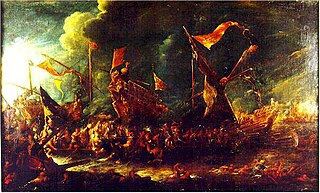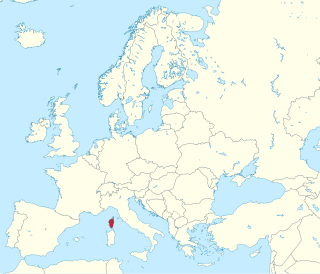
The action of 3 October 1624 was a naval engagement that took place near San Pietro Island, Sardinia, during the war against the Barbary corsairs. A squadron of galleys from the Spain, Grand Duchy of Tuscany and Papal States under Diego Pimentel engaged a squadron of six Algerian ships under Azan Calafate. The Algerians were defeated, their flagship was destroyed, and four ships were captured. Also, the Christian slaves they owned were freed.

The Spanish Armada was a Spanish fleet that sailed from Lisbon in late May 1588, commanded by Alonso de Guzmán, Duke of Medina Sidonia, an aristocrat without previous naval experience appointed by Philip II of Spain. His orders were to sail up the English Channel, join with the Duke of Parma in Flanders, and escort an invasion force that would land in England and overthrow Elizabeth I. Its purpose was to reinstate Catholicism in England, end support for the Dutch Republic, and prevent attacks by English and Dutch privateers against Spanish interests in the Americas.

The Battle of Sluis was a naval battle during the Eighty Years' War in which a Spanish squadron commanded by the Italian captain Federico Spinola tried to break through a blockade of Sluis by Dutch ships under the command of Joos de Moor. After about two hours of fighting the heavily damaged Spanish ships returned to Sluis. Federico Spinola was killed during the action.

The Battle off Lizard Point was a naval action which took place on 18 February 1637 off the coast of Cornwall, England, during the Eighty Years' War. Spanish admiral Miguel de Horna, commander of the Armada of Flanders, intercepted an important Anglo-Dutch merchant convoy of 44 vessels escorted by six Dutch States Navy warships, sinking or capturing 20 ships before returning safely to his base in Dunkirk.

The Battle of Orbetello, also known as the Battle of Isola del Giglio, was a major naval engagement of the Franco-Spanish War of 1635. It was fought on 14 June 1646 off the Spanish-ruled town of Orbetello, on the coast of Tuscany, Italy, between a French fleet led by Admiral Armand de Maillé, Marquis of Brézé, and a Spanish fleet commanded by Miguel de Noronha, 4th Count of Linhares sent to break the blockade of Orbetello and relieve the town, besieged since 12 May by a French army under the command of Prince Thomas of Savoy. The Battle of Orbetello was tactically very unusual, since it was fought by sailing ships towed by galleys in a light breeze.

The battle of Alboran took place on 1 October 1540 off the isle of Alboran during the Ottoman–Habsburg struggle for control of the Mediterranean when a Spanish fleet under the command of Bernardino de Mendoza destroyed an Ottoman fleet commanded by Ali Hamet, sinking a galley and capturing 10 other ships.

The Battle of Berlengas Islands was a naval battle which took place off the Portuguese coast on 15 July 1591, during the war between Elizabeth I of England and Philip II of Spain. It was fought between an English privateer squadron under George Clifford, 3rd Earl of Cumberland, who had set out his fortunes by large-scale privateering, and a squadron of 5 Spanish galleys commanded by Francisco Coloma tasked with patrolling the Portuguese coast against privateers. While anchored off the Berlengas, the English ships were surprised by the Spanish galleys, which succeeded in taking one English ship and rescuing two prizes.
The action of San Mateo Bay or action of Atacames Bay was a naval engagement which took place from 29 June to 1 July 1594 between the galleon Dainty under the command of English privateer Richard Hawkins and a Spanish squadron of three galleons commanded by Beltrán de Castro at the mouth of the Esmeraldas river, nowadays Ecuador.

The Battle of Cape Corvo was a naval engagement of the Ottoman–Habsburg wars fought as part of the struggle for the control of the Mediterranean. It took place in August 1613 near the island of Samos when a Spanish squadron from Sicily, under Admiral Ottavio d'Aragona, engaged an Ottoman fleet led by Sinari Pasha. The Spanish were victorious and captured seven galleys and about 600 prisoners, among them the Bey of Alexandria and another 60 important Ottoman nobles. Cape Corvo was the first major victory of the Spanish fleets under Pedro Téllez-Girón, 3rd Duke of Osuna, the Spanish Viceroy of Sicily, as well as the greatest Spanish victory over the Ottoman Empire since the Battle of Lepanto.

The action of 14 June 1742 was a minor naval battle of the War of the Austrian Succession in which a small British squadron under Captain Richard Norris burned 5 Spanish royal galleys at the French port of Saint Tropez. Norris had surprised the galleys near Sainte-Marguerite and had chased and driven them into the French port. The British captain, in spite of alleged French neutrality, followed the Spanish vessels into the port and destroyed them at slight cost.
The First Battle of the Strait of Gibraltar was a naval engagement that took place on 24 April 1590 during the Anglo-Spanish War. Ten English armed merchant vessels of the Levant Company were met and intercepted by twelve Spanish galleys under Pedro de Acuña in the service of Spain in the region of the Gibraltar Straits. English sources claim that the English were able to repel the galleys inflicting heavy losses after a six-hour fight, while Spanish sources show the battle as indecisive.

The Battle of the Narrow Seas, also known as the Battle of the Goodwin Sands or Battle of the Dover Straits was a naval engagement that took place on 3–4 October 1602 during the Anglo-Spanish War of 1585 and part of the Dutch Revolt. An English fleet under Sir Robert Mansell intercepted and attacked six Spanish galleys under the command of Federico Spinola in the Dover Straits. The battle was fought initially off the coast of England and finally off the Spanish Netherlands. The English were soon joined by a Dutch fleet under Jan Adriaanszoon Cant, and they completed the destruction.
The Battle of Guadalupe Island, also known as the Battle of Guadalupe, was a naval action that took place off Guadalupe Island, Caribbean Sea, on 8 November 1595, between a Spanish force of five frigates commanded by Don Pedro Tello de Guzmán and Don Gonzalo Méndez de Cancio, and an English squadron of nine ships, during the unsuccessful English military expedition of 1595 against Spain and their possessions, led by Sir Francis Drake himself, Sir John Hawkins and Sir Thomas Baskerville, as the context of the Anglo-Spanish War (1585–1604). The result was a Spanish victory. One of the English ships, the Francis, was captured and the others fled from the battle. Then, knowing Drake's plans, the Spanish flotilla took advantage over the bulk of Drake's fleet, and arrived at San Juan on 13 November, reinforcing the town with 500 soldiers and supplies. The Spaniards organized different artillery positions in strategic locations, and the five frigates were positioned to cover the entrance of the bay with their artillery, awaiting the arrival of Drake. On 22 November, with the defenses completed, the English fleet arrived off San Juan and tried to invade the town. The result was another Spanish victory over Drake's forces.

The Battle of Pantelleria (1586), also known as the Fight at Pantalarea was a naval engagement during the Anglo–Spanish War off the island of Pantelleria on 13 July 1586. The encounter was between an English armed merchant fleet of five ships of the Levant Company in convoy under Edward Wilkinson and a fleet of eleven Spanish and Maltese galleys under Don Pedro de Leyva. The English managed to repel all the attacks and returned home unmolested. Although minor, the battle had significant consequences in testing English armaments used against the Spanish armada two years later when England was under threat of invasion.

The Battle of Girolata was a naval action fought between Genoese, Spanish, and Ottoman ships on 15 June 1540 in the Gulf of Girolata, on the west coast of the island of Corsica, amidst the war between Charles V of Spain and Suleiman the Magnificent. A Spanish squadron of 21 galleys led by the Genoese Gianettino Doria and the Spaniard Berenguer de Requesens surprised an Ottoman squadron of 11 galleys, anchored at Girolata, led by the Ottoman admiral Dragut, whom the commander of the Ottoman Navy, Hayreddin Barbarossa, had committed to raid the Italian coast after his victories in the Adriatic Sea the year before. As the crews of the Ottoman warships were ashore, distributing the booty from recent raids, the Spanish-Genoese fleet easily overtook them, taking all 11 Ottoman galleys and making 1,200 prisoners, among them Dragut, who was carried to Genoa and put, together with his captains, to row in Andrea Doria's galleys.

The Battle of Cape St. Vincent was a naval engagement that took place on 16 June or 6 October 1606, during Eighty Years' War and Dutch–Portuguese War. A Spanish fleet under Admiral Luis Fajardo attacked the Dutch fleet led by Admiral Willem Haultain and Vice Admiral Regnier Klaazoon, which was blocking the Spanish-Portuguese coast to intercept the Spanish treasure fleet. The battle concluded in a Spanish victory; in which Klaazoon's flagship was destroyed, two ships were captured, and Haultain fled with the rest of the fleet to his country without having achieved his purpose.

The Capture of the galleon Lion Couronné was a naval engagement that took place off Formentera on 17 June 1651, during the Franco-Spanish War (1635–1659). A squadron of eleven Spanish galleys under John of Austria the Younger captured the French galleon Lion Couronné after a fight.

Dainty was an English race-built galleon that began to be built in 1588. The original name was Repentance, but this was soon changed. It participated in some naval engagements in the Anglo-Spanish War (1585–1604). In 1593 it sailed from England under Richard Hawkins to navigate the Pacific Ocean and circumnavigate the world, but was captured the following year by the Spaniards when it was sailing off the coast of what is now Ecuador. It was commissioned by the Spaniards as Nuestra Señora de la Visitación, serving in the South Pacific for several years. She was also known informarly by her nickname, La Inglesa.

A zabra (zah-brə) was a small or midsized sailing vessel used off the coasts of Spain and Portugal to carry goods by sea from the 13th century until the mid-16th century; they were well-armed to defend themselves against pirates and corsairs.

The Brittany campaign, or the campaign of Brittany, was a military occupation of the Brittany, France, by Spain. It began in summer 1590 when Philippe-Emmanuel de Lorraine, Duke of Mercœur, the governor of Brittany, offered the port of Blavet to King Philip II of Spain so that he could harbour his fleet. The occupation formally ended on May 2, 1598, with the Peace of Vervins.

















